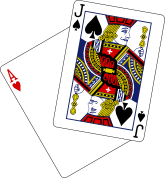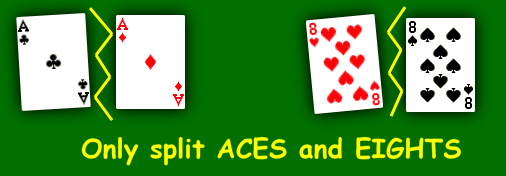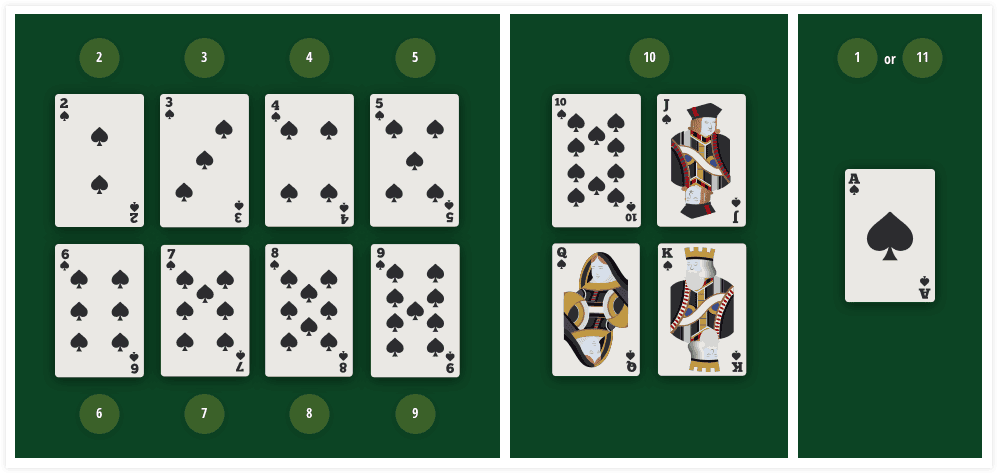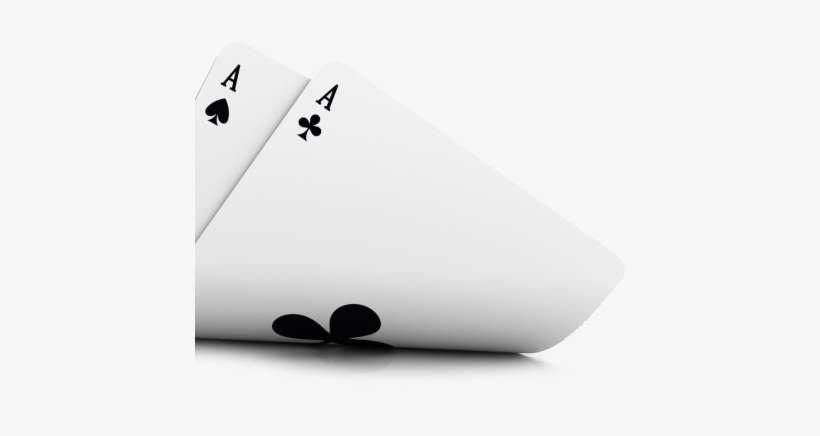What Is Ace In Blackjack
Posted : admin On 4/4/2022Kenny Rogers once sang about how in poker, as well as in life, one must “know when to hold ’em and know when to fold ’em”. This is a very valuable piece of advice indeed but when it comes to blackjack, one must know when to hit, stand, split, and double down. And how do you know which of these moves is correct in any given situation at the blackjack table? You base your decisions on two factors when you follow total-dependent basic strategy – the sum total of your hand and the dealer’s upcard.
An ace is considered hard or soft only when the cards add up to 21 or less. The ace is forced to a 1 (hard) designation when the other cards, when added up, exceed 10. Example: my first card is an ace, my second card is a 6. Dealer has a paint card showing. This is because in blackjack an ace can be counted as one or eleven. When you are dealt a soft hand at the blackjack table, the dealer will speak of your hands as “3 or 13, 4 or 14, 5 or 15,” etc. The Ace is always valued at 11 unless that would result in the hand going over 21, in which case it is valued as 1. Any hand with an Ace valued as 11 is called a ‘soft’ hand. All other hands are ‘hard’ hands. A starting hand of a 10 valued card and an Ace is called a Blackjack or natural and beats all hands other than another Blackjack.
- Bonus$300
- Bonus$300
- Bonus⋆80 Free Spins
Regardless of the number of decks in play, there are only 13 possible card denominations that can appear on the felt – Aces through Kings. Each of the 13 denominations is available in 4 different suits although these are largely irrelevant in the game of blackjack where suits are taken into consideration only when players post certain side bets like Lucky Ladies, King’s Bounty, and suited 777.
The above statement is true about the player’s cards as well as about the dealer’s exposed card, which is why it is of utmost importance for blackjack players to be able to spot the instances when the dealer’s upcard puts them at disadvantage. Similarly, players must be able to recognize which upcards pose as a threat, giving the dealer the upper hand.
Understanding the Rules Blackjack Dealers Abide By
Before a player proceeds to analyze the dealer’s exposed card, they must gain a good understanding of the fixed rules a blackjack dealer abides by. These rules may be different from one blackjack table to another but most of the time, the dealer receives one card facing up (their upcard) and a second one that remains hidden (their hole card) until the time comes for the dealer to act on their hand.
The trouble is blackjack dealers are always the last persons to complete their hand during a round of play. They reveal their hole card only after players have already made their decisions. Thus, the only information the player can work with when making a decision is the total of their hand and the value of the dealer’s exposed card.
Unlike players, the dealers are not allowed to hit their hands as many times as they want (or at least until they bust). Dealers are normally required to draw until they reach a total of at least 17. One exception to this rule is made in the so-called H17 games where the dealer must hit their hand if it is a soft 17, or A-6 (the Ace can be assigned a value of 1 or 11 which makes it impossible for the dealer to bust on the very next hit). Unlike players, the blackjack dealer never surrenders, splits pairs or doubles down regardless of what cards they have been dealt.
Analysis of the Dealer’s Upcards and Their Strength
The only information a total-dependent basic strategy player uses when making a move is their hand’s total and the value of the dealer’s upcard. The correct plays are always the same with basic strategy because the dealer always follows the same fixed rules regardless of what upcard they are showing or what you are holding.

It should be noted basic strategy does not take into account the cards that have been previously dealt or those of your fellow players, which is what card counters do when keeping track of the remaining decks’ composition.
Another important thing to bear in mind has to do with what is considered a “safe” zone for the blackjack player. The average winning total in blackjack is estimated to be 18.5 which is to say players need a hand that totals at least 19 to get into the said safe zone.
Meanwhile, it is estimated the cards that give the dealer an advantage over players appear on the felt 6 out of 13 times on average. The dealer would win most of their hands that start with a strong upcard. You can compensate for this by playing more aggressively, i.e. by splitting and doubling down, when the dealer shows a weak card that puts them at a disadvantage.

The Dealer’s Upcards Additonal TipsThe dealer’s upcard is crucial for yet another reason – it tells you the probability of the dealer breaking their hand by exceeding 21. Let’s now examine which dealer upcards pose as a threat for the player and which ones put the dealer in weak spots. Keep in mind the probability percentage figures we have listed below are accurate for six-deck games where dealers abide by the S17 rule.
Tread Carefully against a Dealer 2 or 3
Players are recommended to tread more cautiously when the dealer exposes cards of value 2 or 3. The only information you are getting in this case is that the dealer is certainly not sitting on a pat hand and will have to take at least one hit to reach their obligatory total of 17 or higher.
The probability of the dealer busting with these upcards is relatively decent. It stands at around 35% when the dealer shows a 2 and at 37.41% when their upcard is a 3. Respectively, the player holds an advantage of nearly 10% against the dealer’s 2 and almost 13.5% against their 3. Despite this, the basic strategy for both multiple-deck S17 and H17 games recommend you to stand on hard totals of 13 through 17 when the dealer shows a 2 or a 3.
Standing is the optimal play in this case because the dealer has higher chances of exceeding 21 with these small cards than improving their total. If you take a hit, you may break your hand yourself.
Play More Aggressively against Dealer Upcards 4, 5, and 6
Basic strategy is based on computer simulations where millions of hands were played against any of the 13 possible dealer upcards. These simulations established that the weakest upcards for the dealer are those of value 4, 5, and 6. This is slightly counterintuitive and gets some players confused causing them to make incorrect plays at the table.
But as British mathematician James Joseph Sylvester famously claimed, “Mathematics is the music of reason”. The dealer’s probabilities of busting with these upcards are 39.58% for the 4, 41.84% for the 5, and 42.28% for the 6. Why are these cards so harmful to the dealer?
The reason is actually quite simple and logical – each time the dealer exposes one of these values, they are bound to take at least one hit even if they have a ten-value card in the hole. When the dealer starts with a 6, for example, but their hole card is a Queen, they will be forced to draw another card on their hard 16. Any card with a value that ranges between 6 and 10 will break their hand and cause you to become an automatic winner (unless you have busted, of course).
The dealer starts their hand with these weak cards only 3 out of 13 times on average, which is why you should always take advantage of these favorable situations. How? By increasing the amount of action you have on the table. Basic strategy tells you to always double down on hard totals 9 through 11 and split pairs 2-2, 3-3, 6-6, 7-7, 8-8, 9-9, and A-A when the dealer exposes these weak cards.
With soft totals 15 through 17, you are again recommended to double against a dealer with these upcards. If your cards do not allow you to split or double, you stand on hard totals of 12 or higher – there is no need to risk busting yourself when the dealer’s chances of doing the same are that high.

Proceed with Caution when the Dealer Exposes 7s or 8s
In blackjack, the cards with a pip value of 7 and 8 are considered neutral because they favor neither the house nor the player. Be careful when your dealer exposes a 7 or 8, though, even more so, if you hold a hand that you can easily break with a hit. The dealer’s chances of busting with these cards are slimmer at 26.19% for the 7 and 24.36% for the 8.
Basic strategy for a six-deck S17 game recommends you to hit hard totals 12 through 16 against a dealer 7 or 8 and stand on hard totals of 17 or higher. With soft hands, you hit soft 13 through 17. The pairs you can split against a dealer with a 7 are those consisting of 2-2, 3-3, 7-7, 8-8, and A-A. Pairs of 9-9 against a dealer 7 call for standing while pairs 8-8, 9-9, and A-A against a dealer 8 call for a split.
Be Very Careful when the Dealer Shows Cards 9 through Ace
A dealer exposing upcards with values 9 through Ace puts you in a rather tricky situation. You will lose most of your hands against those upcards because they are advantageous to the dealer and do not allow you to build much of an edge on your hands. On average, the dealer will pull these strong upcards 6 out of 13 hands because there are 4 ten-value cards apart from the Ace and the 9 (10, Jack, Queen, and King).
It would be best to refrain from playing aggressively and adopt a more conservative approach when you are at disadvantage. The probability of the dealer busting with a 9 or a ten-value card now drops to around 23% whereas that of them breaking their hand with an Ace in the hole stands at 16.70% for a six-deck S17 game.
In accordance with basic strategy, you are expected to hit hard totals 12 through 15 against a 9 and an Ace in a desperate attempt to outdraw the dealer. The game goes when you have hard hands 12 through 14 against a dealer 10. Surrendering is advisable with hard 16 against any of the three strong dealer cards. If this is not an option, you hit your hard 16.

Several Important Things to Bear in Mind
There are many myths about the game of 21 but tackle those in more detail in a separate article. For now, we shall only broach the subject of always assuming the dealer has a 10 in the hole and give you some handy tips on how to approach certain two-card totals depending on their upcard.
The Incorrect Assumption the Dealer Has a 10 in the Hole
Many misguided blackjack players would recommend others to always assume the dealer’s hole card has a value of 10. However, one such assumption is utter rubbish from a probability perspective. This “tactic” fails to accomplish everything else but an increase in the house edge. Some would even go as far as to assure you that it is basic strategy this assumption is based on. Both statements hold no truthfulness and here is why.
In a full deck, only 16 cards are assigned a value of ten as there are 4 Tens, 4 Jacks, 4 Queens, and 4 Kings. The remaining 36 cards are of different values, which is to say the probability of a ten-value card appearing stands at 16/52, or roughly 30.8%. Respectively, the odds of one such card making an appearance are 36 to 16 which is to say a ten-value card is dealt once per every 3.25 hands on average. Why should one assume it is dealt more often than this is beyond us.
It goes without saying basic strategy does not recommend playing by this rule, either. If it did, some of the correct plays listed in the strategy charts would be vastly different. An example can be given with a hard hand of 17. If the dealer reveals an 8, for example, and we assume their hole card has a value of ten, you would have been recommended to hit your hard 17 because otherwise it cannot beat the dealer’s 18. Yet, basic strategy advises players to stand on their 17s when the dealer’s upcard is an 8.
Remember basic strategy is not based on information we do not have. The correct plays it recommends rely only on the cards you can see and making any other assumption will cost you a small fortune over the long run.
The Rule of 9 and How It Helps You with Some Soft-Doubling Decisions
The “Rule of 10”, as the above assumption is called, is absolute bosh but fortunately, we cannot say the same about the “Rule of 9”. The latter can be quite useful when you are struggling with a doubling decision on soft 13 through soft 18. Soft doubles are the hardest part of basic strategy to remember but the Rule of 9 can help you with that.
This rule uses the dealer’s upcard as a reference point. You never double on anything when the dealer shows a deuce because you will lose too often with this play. Doubling on soft 13 through 18 is always a good idea when the dealer’s upcard is a 5 or a 6 because this puts them in the weakest possible spot and you want to take full advantage of the fact.
Doubling on soft hands gets trickier when the dealer exposes a 3 or a 4 but not when you abide by the Rule of 9. This is how it works. All you have to do is add up the value of the dealer’s upcard and that of the card next to your Ace, be it 3, 4, 5, 6, or 7. If the result is equal to 9 or is higher, you must double on your soft hand.

Let’s finish off with a couple of quick examples to put the rule to practice. What do you do with A-6 against a dealer 4? You double because the sum total of 6 and 4 is higher than 9. What about A-4 against a dealer 3? You refrain from doubling and hit your soft 15 instead since the total of the two cards’ value is lower than 9. If you check the strategy chart, you will see you are indeed recommended to hit a soft 15 when the dealer’s upcard is a 3.
Mar 26, 2014
If you’re a fan of gambling you’ll know what blackjack is; but do you know how the famous game got its name?
Blackjack is a world renowned card game and anyone who gambles or visits casinos knows what it is; hell even if you’ve never done either of these things chances are you know what blackjack is, or will have at least heard of it.
Blackjack is one of the simplest casino games to play; each player is dealt two cards and you all play against the dealer trying to reach 21. Players can request additional cards if the two dealt are not as close to 21 as they’d like to be. Go over 21 and you lose, if the dealer goes over then everyone still in the hand wins.
So how did the game start, and what kind of a name is blackjack? This article takes a look and the blackjack history, how it began and of course how it got its name.
The origin of the game
As with quite a few popular casino games, the history of blackjack is not particularly straight-forward and the specific origin is often disputed. There are a few popular theories attributed to the game. Many scholars believe that blackjack was derived from French games such as French Ferme, a derivative of baccarat, and Chemin de fer both of which have similar elements.
However, the generally accepted consensus is that it derived from another French game known as vingt-et-un, which literally translates as twenty-and-one; given the nature of blackjack, this idea seems most probable.
Vingt-et-un began appearing in French casinos in the early 1700’s, but it would be arriving in America for another century. Once it had arrived, under the name Twenty-One, the game began to gain a small following; but it wasn’t until it became known as blackjack that it started getting the same attention which it still enjoys now.
Blackjack: The name
So how did the game of twenty-one become known as it is today, by the name of Blackjack?
Famous Card Counters
• Ken Uston
• Al Francesco
• Edward O. Thorp
• Tommy Hyland
Once The United States got over some of those annoying anti-gambling policies, and Nevada led the way in the legalization of gambling, the game was offered at the first American casinos. However, patrons were reluctant to play the game and casino operators had to come up with some smart strategies to help with the gains popularity.
To attract more players to bet at the blackjack tables, managers and owners of gambling houses thought of ways to give bonus payouts to the winners. One example is the ‘blackjack bonus’, which had a ten-to-one payout – your stake come back tenfold if you win – when the player gets an ace of spades and any black jack. The black jacks are the jack of spades and the jack of clubs.
The popularity of the game increased rapidly and players would refer to the tables as blackjack tables, even after the ten-to-one bonuses had stopped being offered; the name stuck and Twenty-One became Blackjack. In today’s game the rules have changed a bit and any ace card and any of the tens, jacks, queens and kings can give a player blackjack.
Beating the dealer: Card counting
You can’t really have an article about blackjack and not mention the card counting system; it just wouldn’t be right.
Card counting is a casino card game strategy used to determine whether the next hand is likely to give a probable advantage to the player or to the dealer. Card counters are a class of advantage players, who attempt to decrease the inherent casino house edge by keeping a running tally of all high and low valued cards seen by the player. I’m sure you’ve seen rain man, so you get the idea.
Counting cards allows players to bet more with less risk, but doing so puts them in risk of repercussions at the hands of the casino. Casinos don’t like having their advantage taken away from them and although it’s not against the law to use such a system when playing, if you’re caught you’ll be escorted out – at the very least.
It has been known for people to get seriously beaten once their behavior has been detected, usually in a casino backroom or basement; but yeah they probably just walked into a door, right?
Be careful if you want to take on the casinos and count cards.
So to summarize, the famous game is probably the product of a few different French card games which merged together into Twenty-One; which then went through a series of promotional casino odds offerings, to increase popularity, and finally became named after one of them; and after all that, modern Blackjack was born.
If you’re a fan of the game you needn’t look too far to enjoy playing a hand, as literally every single casino worldwide will offer the game, and although they don’t still have a ten-to-one payout most places will still give you a good incentive with a three-to-two payout.
No wonder, with its simplicity and with giving the players a good advantage, blackjack became and remains popular in many gambling houses and casinos.
What Does Ace Mean In Blackjack
Tags: 21, Ace of Spades, Al Francesco, American casinos, beat the dealer, Blackjack, blackjack history, blackjack name origin, card counters, Card counting, card counting system, casino card game strategy, Chemin de fer, counting cards, Edward O. Thorp, French Ferme, Ken Uston, Nevada, Origin of blackjack, smart strategies, the history of blackjack, Tommy Hyland, twenty-one, vingt-et-un
What Is The Ace In Blackjack
What Is Double Ace In Blackjack
Related posts:What Is The Ace In Blackjack
- 4 Foolproof Ways to Get Yourself into the Blackjack Hall of Fame
Blackjack hall of fame members Edward O. Thorp and Al Francesco are famous for pioneering... - Banned for Good: Blacklisted Blackjack Counters
Blacklisted blackjack counters are always polarizing, with some seeing them as heroes and others as... - 4 Ways People Tried to Save Their Ass by Playing Blackjack
Sometimes, when the chips are down, people hit the blackjack tables to try and change... - Blackjack Insurance: What is it Good For and Should I ever Use it?
Blackjack insurance seems to favor the player, but does it actually, and should players ever... - The Blackjack Hall of Fame
We take a look at the blackjack hall of fame and some of its illustrious...